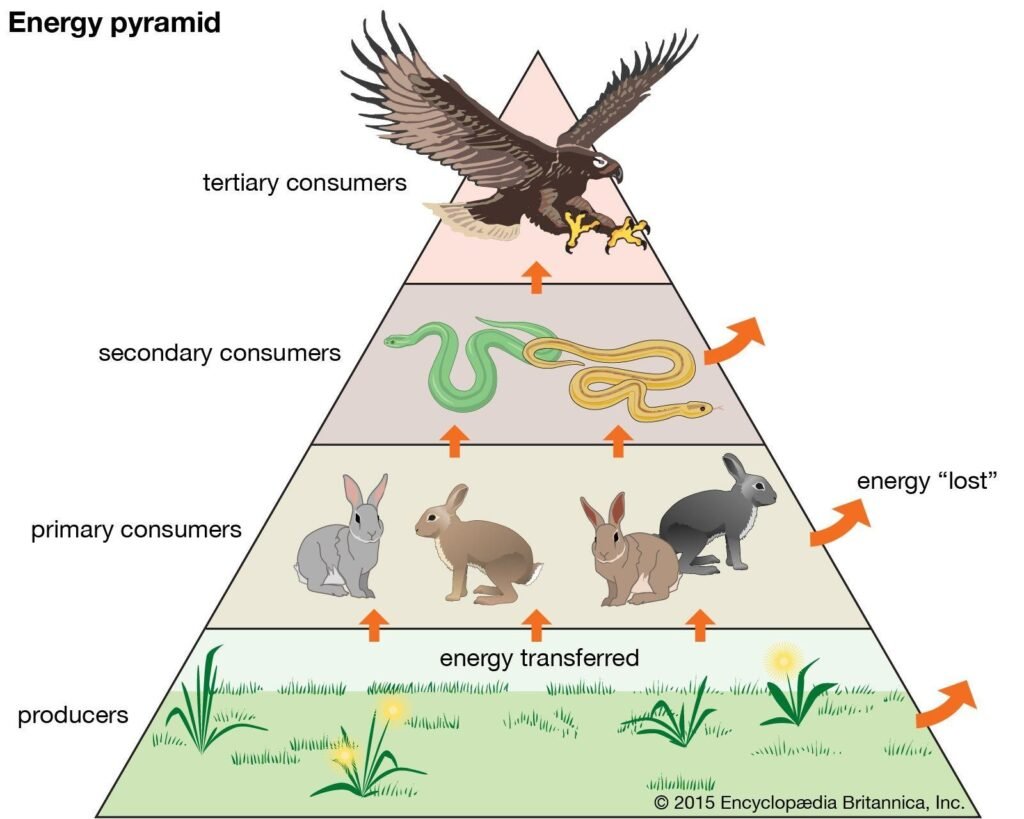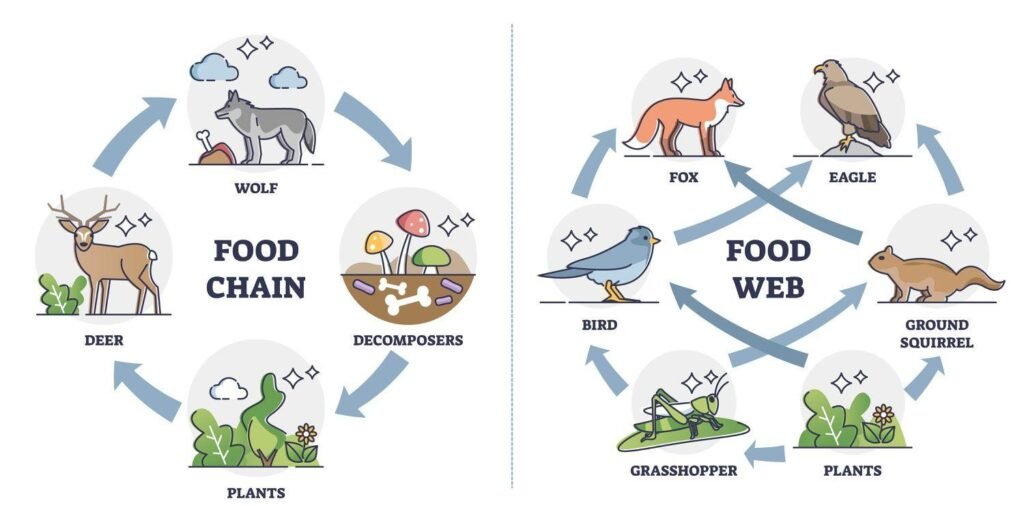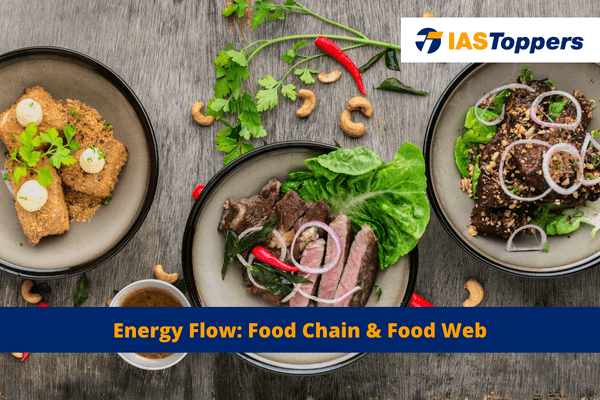Energy flow in Ecosystem refers to the transfer of energy from the sun through each level of the food chain. It is facilitated by the interconnected food chain and food web, with the sun serving as the primary source of energy. This unidirectional energy flow is essential for maintaining the ecological balance.
Energy Flow in Ecosystem will be helpful for UPSC IAS Exam preparation. GS Paper-3 Environment.
Table of Content
- What is Energy Flow in Ecosystem?
- Trophic level
- Ecological Pyramids
- Food Chain and Food web
- Conclusion
- Frequently Asked Questions (FAQs)
What is Energy Flow in Ecosystem?
- Definition: Energy flow is the transfer of energy from the sun and up each subsequent level of the food chain in an environment.
- The energy flow in ecosystem is given by the food chain and food web.
- The primary source of energy for almost every ecosystem on Earth is the sun.
- During the process of energy flow in the ecosystem, plants being the producers absorb sunlight with the help of the chloroplasts and a part of it is transformed into chemical energy in the process of photosynthesis.
- This energy is stored in various organic products in the plants and is transferred to the primary consumers when they eat the plants.
- Secondary consumers, such as carnivores of the first order, ingest herbivores and further degradation of energy occurs.
- Tertiary consumers consume carnivores, and energy is again degraded.
- Energy flow in an ecosystem is always unidirectional in nature, and it moves from the sun to producers, then to primary consumers, secondary consumers, and finally to tertiary consumers.
- Energy flow is important to maintain an ecological balance, and photosyn the sizers are the only “gateway” for energy to flow into food webs.

Trophic level
A trophic level is a group of organisms within an ecosystem that occupy the same level in a food chain. Every level in the food chain is known as a trophic level.
- Autotrophs are organisms that can produce their own food using light, water, carbon dioxide, or other chemicals.
- Plants are the most familiar type of autotroph, but there are many different kinds of autotrophic organisms.
- Autotrophs use processes like photosynthesis to convert solar energy, carbon dioxide gas, and water into carbohydrates like glucose and oxygen gas.
Autotrophs occupy the lowest trophic level in a food chain, and they are the primary producers of energy in grazing food chains.
- Herbivores are organisms that primarily eat plants. e.g., insects, rodents, birds, and ruminants.
- Carnivores are organisms that primarily eat meat or the flesh of other animals.
- Carnivores are sometimes called predators.
- Examples: frog, dog, cat, tiger etc.
- Omnivores are organisms that regularly consume a variety of materials, including plants, animals, algae, and fungi.
- Examples: bear, man etc.
- Detritivores (decomposers) are organisms that feed on dead organic matter or detritus.
- Examples: bacteria, fungi etc.
Ecological Pyramids

- Ecological pyramids provide a visual way to show the different levels of a food chain in an ecosystem.
- These pyramid shapes, resembling triangles, can be divided into three specific kinds.
- The base of the pyramid represents the first level, which consists of the producers.
- Above that, it has tiers that represent herbivores, carnivores, and finally, the top carnivores.
Refer to the linked article to know more details about Ecological Pyramids.
Food Chain and Food Web

| Food Chain | Food Web | |
| Definition | A linear sequence of organisms where nutrients and energy flow as one organism consumes another. | A complex network of interconnecting food chains, depicting the feeding relationships within a community. |
| Representation | It is a simplistic representation of community structure. | It is a more comprehensive model that accounts for all interactions and complex relationships among species in an ecosystem. |
| Transfer of Energy | It shows the transfer of matter and energy from one organism to another. | It illustrates how multiple food chains intertwine and interact, resulting in a more diverse flow of matter and energy. |
| Inclusion of | Food chains do not incorporate decomposers. | Food webs involve a broader range of organisms, including decomposers, in addition to the animals present in food chains. |
| Complexity | Food chains provide a basic understanding of energy flow but lack the intricate details of a complete ecosystem structure. | Food webs offer a more comprehensive and intricate representation of the interactions and relationships within an ecosystem. |
Refer to the linked articles to know more details about Food Chain and Food Web.
Conclusion
Energy flow plays an important role in maintaining the equilibrium of ecosystems. It enables the sustenance of various trophic levels, ensuring the transfer of matter and energy from the sun to producers, primary consumers, secondary consumers, and tertiary consumers. Understanding energy flow provides insights into the intricate relationships and interactions within an ecosystem, contributing to its overall stability and functioning.
Ref: Source-1
| Other Articles in Environment & Disaster Management | |
| Food Chain | Food Crops |
| Food Web | Ecological Pyramid |
| Oxygen Cycle | Phosphorus Cycle |
FAQs (frequently asked question)
Give reason: energy flow through an ecosystem is one way.
The flow of energy in an ecosystem is unidirectional known as a food chain, where it moves from one organism to another. This flow of energy is characterized by its one-way nature, as it does not return to its source. Primary producers, such as plants, play a crucial role as they harness solar energy through photosynthesis to synthesize their own food.
Why the flow of energy is unidirectional? Explain.
The flow of energy within ecosystems is always unidirectional due to the inability of plants to reuse the energy lost as heat from organisms in a food chain during the process of photosynthesis. As energy passes through different trophic levels in an ecosystem, there is a continuous loss of energy throughout the transfer. This cumulative loss accounts for the unidirectional nature of energy flow in ecosystems.
What are the stages of energy flow in an ecosystem? Or How Energy flow in Ecosystem?
The foundation of the pyramid consists of producers, which generate their own food through photosynthesis or chemosynthesis. Moving up, the second level comprises herbivores or primary consumers. The following tiers of the pyramid are occupied by secondary and tertiary consumers, including omnivores and carnivores.

